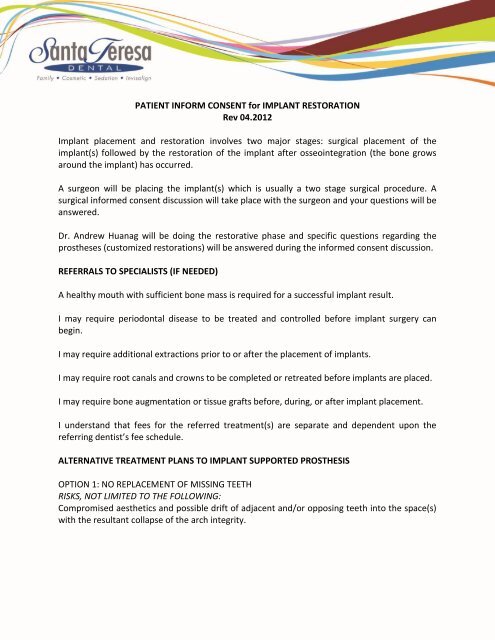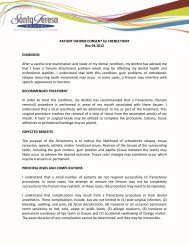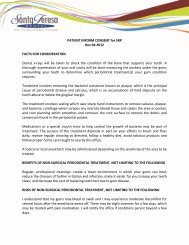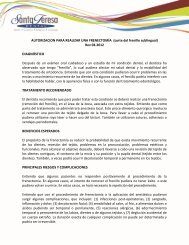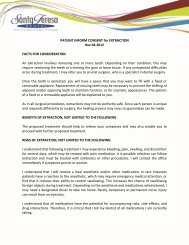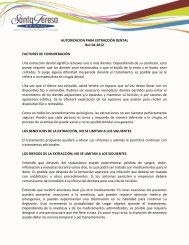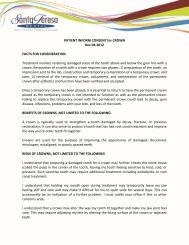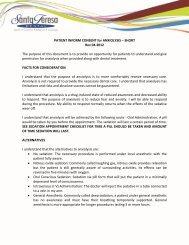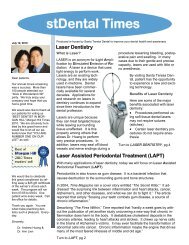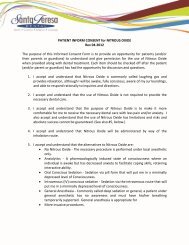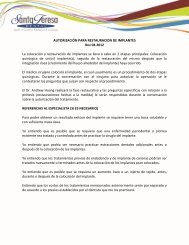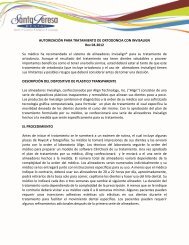Implant Restoration - Consent Form
Implant Restoration - Consent Form
Implant Restoration - Consent Form
You also want an ePaper? Increase the reach of your titles
YUMPU automatically turns print PDFs into web optimized ePapers that Google loves.
PATIENT INFORM CONSENT for IMPLANT RESTORATION<br />
Rev 04.2012<br />
<strong>Implant</strong> placement and restoration involves two major stages: surgical placement of the<br />
implant(s) followed by the restoration of the implant after osseointegration (the bone grows<br />
around the implant) has occurred.<br />
A surgeon will be placing the implant(s) which is usually a two stage surgical procedure. A<br />
surgical informed consent discussion will take place with the surgeon and your questions will be<br />
answered.<br />
Dr. Andrew Huanag will be doing the restorative phase and specific questions regarding the<br />
prostheses (customized restorations) will be answered during the informed consent discussion.<br />
REFERRALS TO SPECIALISTS (IF NEEDED)<br />
A healthy mouth with sufficient bone mass is required for a successful implant result.<br />
I may require periodontal disease to be treated and controlled before implant surgery can<br />
begin.<br />
I may require additional extractions prior to or after the placement of implants.<br />
I may require root canals and crowns to be completed or retreated before implants are placed.<br />
I may require bone augmentation or tissue grafts before, during, or after implant placement.<br />
I understand that fees for the referred treatment(s) are separate and dependent upon the<br />
referring dentist’s fee schedule.<br />
ALTERNATIVE TREATMENT PLANS TO IMPLANT SUPPORTED PROSTHESIS<br />
OPTION 1: NO REPLACEMENT OF MISSING TEETH<br />
RISKS, NOT LIMITED TO THE FOLLOWING:<br />
Compromised aesthetics and possible drift of adjacent and/or opposing teeth into the space(s)<br />
with the resultant collapse of the arch integrity.
BENEFITS, NOT LIMITING TO THE FOLLOWING:<br />
No additional cost at this time.<br />
CONSEQUENCES IF NO TREATMENT IS ADMINISTERED, NOT LIMITED TO THE FOLLOWING:<br />
I understand that I can choose to do nothing and my present complaints will continue and may<br />
worsen. Subsequent choices for repairs may become more difficult, expensive, or not feasible.<br />
OPTION 2: REMOVABLE APPLIANCE<br />
RISKS, NOT LIMITED TO THE FOLLOWING:<br />
Removable prosthetic appliances are customized replacements of natural teeth, which rest on<br />
the ridges/gums or on the adjacent teeth, and may cause wear or increased loading on those<br />
teeth.<br />
I understand that there are potential problems such as: periodontal (gum) disease, porcelain<br />
fractures, occlusal changes, stains and color changes, gum recession, food impaction, decay,<br />
excessive wear due to grinding and burning, temporomandibular joint dysfunction (TMJD), and<br />
others.<br />
Since the prosthesis is removable, I understand that it also may have characteristics and<br />
potential problems that natural teeth do not have, such as: odor, chipping, and wear; stability<br />
and retention problems; changes in facial and lip appearance; and adaptation of the tongue and<br />
lips for proper speech. Periodic relines may be required as gums and bone may change over<br />
time, oral sensations may change, and good oral hygiene is imperative.<br />
BENEFITS, NOT LIMITING TO THE FOLLOWING:<br />
I understand that a reasonable aesthetic appearance may be achieved, and my ability to speak<br />
and chew can be improved.<br />
CONSEQUENCES OF TREATMENT, NOT LIMITING TO THE FOLLOWING:<br />
I understand that I may have an adjustment period to adapt my speech and chewing after the<br />
prosthesis is placed.<br />
I understand that daily hygienic care by me combined with regular cleanings and checkups at<br />
my dentist’s office are necessary for the health of my entire mouth and the proper<br />
maintenance of my prosthesis.
OPTION 3: FIXED APPLIANCE<br />
RISKS, NOT LIMITED TO THE FOLLOWING:<br />
Fixed prostheses are customized restorations or replacements of missing teeth that are<br />
cemented and anchored to adjoining teeth.<br />
I understand the potential problems with fixed prostheses are the same as with my real teeth,<br />
such as: periodontal (gum) disease, porcelain fractures, occlusal changes, color changes, food<br />
impaction, decay, excessive wear due to grinding and burning, temporomandibular joint<br />
dysfunction (TMJD), and others.<br />
BENEFITS, NOT LIMITED TO THE FOLLOWING:<br />
I understand that a reasonable aesthetic appearance can be achieved, and my ability to speak<br />
and chew can be improved.<br />
CONSEQUENCES OF TREATMENT, NOT LIMITING TO THE FOLLOWING:<br />
I understand there are reasonable compromises I must adjust to when I wear prostheses<br />
because they are not my natural teeth. The exact color and shape of my natural teeth can only<br />
be approximated; loading on the supporting teeth will be increased and they will require<br />
preparation prior to crowning.<br />
I understand that I may have an adjustment period to adapt my speech after the prosthesis is<br />
permanently cemented in place.<br />
I understand that daily oral hygiene care by me, combined with regular cleanings and check-ups<br />
at my dentist’s office are necessary for the health of my entire mouth and the proper<br />
maintenance of my prosthesis.<br />
THE IMPLANT TREATMENT PLAN - RESTORATION(S)<br />
FACTS FOR CONSIDERATION<br />
After surgical placement of the implants is completed and healed, the construction of the<br />
prostheses begins. This phase may require many appointments for evaluation, measurement,<br />
gum preparation, and placement of the prostheses.
RISKS, NOT LIMITING TO THE FOLLOWING<br />
I understand the new prosthesis may be fixed and have similar risks, benefits, and<br />
consequences as the fixed prosthesis previously described (which I have discussed with my<br />
dentist). However, being anchored to an implant, integrated in my bone, this type of fixed<br />
prosthesis will function more like my natural teeth.<br />
I understand the new prosthesis may be either removable by the dentist, but not by the<br />
patient, or it may be removable by the patient. If so, it will have similar risks, benefits, and<br />
consequences as the removable prosthesis described above (which I have discussed with my<br />
dentist). However, being anchored to an implant integrated in my bone, this type of removable<br />
prosthetic appliance will function more like my natural teeth.<br />
I understand that my implant(s) may not fully integrate following surgery even though they<br />
appear to be integrated after healing is completed. I understand if an individual implant must<br />
be removed, the prosthesis may still be retained but will be supported by fewer implants and<br />
thus place a greater load on the remaining implants which may have adverse consequences. I<br />
understand that the success of the prosthesis depends upon the location, angle, and number of<br />
retained implants.<br />
I understand that sometimes implants fail completely and must be removed, requiring a change<br />
in treatment considerations and a fabrication of a conventional prosthesis, instead. If that<br />
should happen, there will probably be less bone than there was before the implant surgery.<br />
I understand that when Osseo integration (bone grows around the implant) is successful, the<br />
implant supports a firmly anchored prosthesis with sufficient function; however, aesthetic<br />
compromises that are sensitive to the patient may nevertheless result. I have discussed these<br />
with my dentist and am willing to work with my dentist to achieve a realistic outcome.<br />
I understand that following implant surgery and the placement of the prosthesis there may be<br />
inflammation of the gum tissue around the posts, and there may be some excess tissue growth<br />
or recession. Some situations may require surgical alteration of the tissue. I understand that<br />
there will be progressive loss of the bone height around the implant over the life of the implant<br />
that may ultimately affect the prosthesis.
BENEFITS, NOT LIMITED TO THE FOLLOWING<br />
I understand that a reasonable aesthetic appearance of my edentulous (toothless) areas can be<br />
reached, and my ability to chew can be improved.<br />
CONSEQUENCES, NOT LIMITED TO THE FOLLOWING<br />
I understand that it is essential to maintain excellent oral hygiene which may not be easy to<br />
achieve. I am committed to a lifetime of regular home cleaning and periodic professional dental<br />
hygiene visits. There will be space for cleaning around the implants, though it may be difficult<br />
for me until I learn the skill.<br />
I understand that smoking, excessive alcohol consumption, chewing hard foods such as ice or<br />
hard candy, may result in damage to my implants and cause them to fail completely.<br />
I understand that a medical condition can compromise the longevity of an implant.<br />
I understand that there may be a feeling of awkwardness with the new prosthesis. The implant<br />
post(s) may seem to be in places where I find them difficult to accommodate, and my speech<br />
may be labored until I am used to the new prosthesis.<br />
PATIENT CONCERNS/QUESTIONS<br />
I attest I have had a discussion with Dr. Andrew Huang, who has explained the alternative<br />
dental treatments available for my toothless areas. The risks, benefits, and consequences of the<br />
prosthetic stages of implant treatment have been thoroughly discussed, and I understand and<br />
accept them.<br />
I have had my questions answered to my satisfaction.<br />
I understand that the placement of implants and the making of the compatible prosthetic<br />
devices are two separate treatments with separate expenses and separate risks and benefits.<br />
I understand that in addition to the risks and complications associated with implants and<br />
prosthetics, certain complications may result from the use of anesthetics or sedatives. The risks,<br />
benefits, and alternatives regarding anesthesia will be explained to me, and I will disclose any<br />
allergies I have because they may affect my response to the anesthetic. The dentist<br />
administering the anesthetic will conduct a separate discussion with me and require a separate<br />
informed consent discussion.
I consent to have implanted supported restorations designed, fitted and placed by Dr. Andrew<br />
Huang who will be consulting with the surgeon of my choice to surgically place the necessary<br />
implants for my implant treatment plan. I accept the financial responsibility to pay for the<br />
prosthesis, and for the continued lifetime maintenance required for the success of my implant<br />
treatment.<br />
No guarantee or assurance has been given to me by anyone that the proposed treatment or<br />
surgery will cure or improve the condition(s) listed above.<br />
I have been given the opportunity to ask questions and give my consent for the proposed<br />
treatment as described above.


